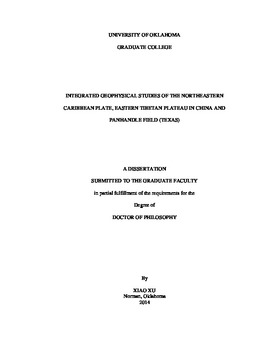| dc.contributor.advisor | Keller, G. Randy | |
| dc.contributor.author | Xu, Xiao | |
| dc.date.accessioned | 2014-07-28T16:35:32Z | |
| dc.date.available | 2014-07-28T16:35:32Z | |
| dc.date.issued | 2014-06 | |
| dc.identifier.uri | https://hdl.handle.net/11244/10458 | |
| dc.description.abstract | There are three different areas and research projects that are the targets of this proposed dissertation. These projects have the common theme of integration of a variety of data but are at different scales. The first one focuses on plate scale interactions in northeastern Caribbean at a lithospheric scale. The second one focuses on crustal scale deformation in the eastern Tibetan Plateau. The last project is in the Panhandle oil and gas field in Texas and targets the structure of basement and seismic attributes of reservoirs.
The first project targets slab dip variations of the Caribbean Plate along the Muertos Trough, which bounds the Puerto Rico-Virgin Islands tectonic block on the south. Results of this research are intended to contribute to understanding the kinematic evolution of this region and the associated natural hazards. Two-dimensional gravity modeling is being employed to address this question for the first time. Integration of the potential field data and seismic data is providing details on the geometry of the subducting slab of the northeastern Caribbean plate. To further reveal the 3D deep structural geometry, P wave tomography is also being used in this research.
The second project aims to explore the lithospheric structure across the Songpan-Ganzi terrane, LMS and western Sichuan basin by undertaking an integrated analysis of deep seismic profiling, gravity, magnetic, and geologic data. Based on our new results and previous research, a 2D numerical simulation was conducted using three initial models with different viscosity structures. These modeling results show that the uplift and crustal thickening observed can be due simply to ductile deformation in the middle crust west of the LMSFZ.
xiv
The third project focuses on the igneous basement structures of Panhandle Field in northern Texas by integrating 3D seismic reflection data, aeromagnetic data and gravity data. The gravity and magnetic data are the useful tool to identify these igneous basement structures. The high-resolution 3D seismic data were collected in Gray County, Texas. I employ volumetric seismic attributes such as instantaneous frequency, instantaneous phase and cosine instantaneous phase derived from 3D seismic data to better characterize subtle features such as collapse features, faulting and fracturing within the deposits that are difficult to detect on conventional 3D seismic data displays. Our research show the igneous basement has been broken into a series of grabens and horsts bounding with normal and reverse faults due to rifting, uplifting and left-lateral deformation. | en_US |
| dc.language | en_US | en_US |
| dc.subject | Geophysics. | en_US |
| dc.title | Integrated Geophysical Studies of The Northeastern Caribbean Plate, Eastern Tibetan Plateau in China and Panhandle Field (Texas) | en_US |
| dc.contributor.committeeMember | Marfurt, Kurt | |
| dc.contributor.committeeMember | Yuan, May | |
| dc.contributor.committeeMember | Rich, Jamie | |
| dc.contributor.committeeMember | Mickus, Kevin | |
| dc.date.manuscript | 2014-06 | |
| dc.thesis.degree | Ph.D. | en_US |
| ou.group | Mewbourne College of Earth and Energy::Conoco Phillips School of Geology and Geophysics | |
